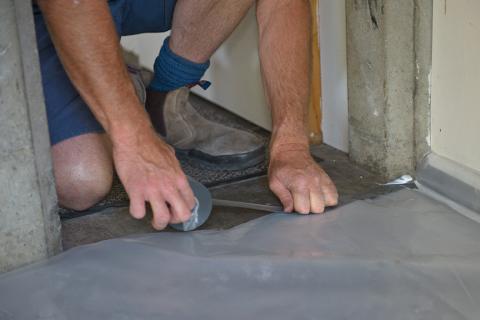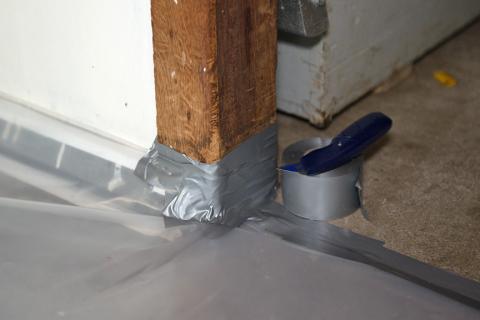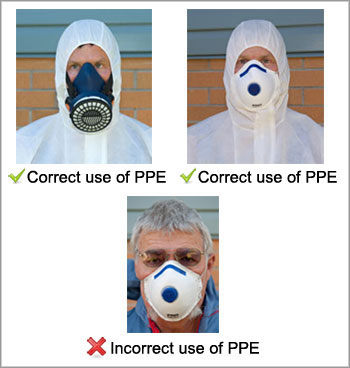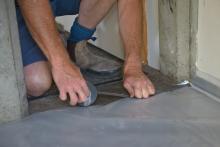- Home
- Resources
- Safe work procedures
- Preparation before commencing the task
Asbestos
Preparation before commencing the task
It's essential that you take all the necessary precautions to protect yourself and others when dealing with asbestos. These steps outline ways to assess the risk, ensure you have adequate training and understanding of how minimise any exposure to asbestos through adequate preparation of the work area.
Risk assessment
A job specific risk assessment must be conducted prior to commencing any possible asbestos work, and include:
- assessing the work to be performed
- understanding to what degree there is the likelihood of disturbing asbestos containing material (ACM)
- inspecting the asbestos register and a decision made as to whether work can be done without disturbing ACM e.g. instead of drilling a hole for wiring consider re-routing the wiring through non-asbestos material
- inspecting and evaluating the material to determine if it is ACM. If a sample analysis has not been conducted, assume that the material is ACM
- assessing the ACM's condition as to whether it is in sound condition or deteriorating and liable to damage
- assessing implementation of job-specific control measures including:
- maintaining a safe distance between barriers and the work area
- assessing the types and level of personal protective equipment (PPE) required to manage the risk of exposure to airborne asbestos fibres
- considering other hazards that may impact on the work (e.g. live electric cables in wall cavity, working at heights, working on brittle roofs, confined spaces, heat stress, vermin or pests).
Training of workers
Person conducting a business or undertaking (PCBU) must ensure that workers have received training in and aware of:
- in situ identification of asbestos-containing materials, including their common locations
- identification of appropriate safe work procedures when working with ACM
- decontamination procedures
- appropriate selection of ACM waste disposal
- respirator use and fit
- relevant codes of practices, fact sheets and work guidance notes.
Site preparation
To prepare the site for work with asbestos:
- ensure that the asbestos register has been sighted to verify the presence of ACM, or ensure that a competent person has identified ACM in the work area
- ensure the work area access permit has been completed
- prepare a written work procedure for the activity (unless a standard safe work procedure applies)
- determine the number of workers required on site (always perform asbestos-related work with the lowest number of workers possible in the asbestos work area)
- determine the need for a second experienced worker to assist with the works (e.g. shadow vacuuming or the need for a worker to remain on duty outside the asbestos work area)
- advise the site occupants of the intended works
- ensure there is adequate lighting for the work area
- establish a buffer zone to separate the work area, by closing all doors to the work area or using plastic curtaining, barricades, signage, and relevant instruction to workers and others
- erect all safety signage
- cover the floor with two layers of the 200 μm PVC plastic sheeting and secure with duct tape
- remove all loose furniture and items from the work area or cover with a 200 um plastic cover and secure with duct tape
- have all equipment ready in the work area (to minimise movement in and out of the area)
- identify potential electrical hazards e.g. cabling in wall cavity
- shut down air conditioning and vent systems (if applicable); seal ducts and vents with 200 μm PVC plastic sheeting and duct tape
- control exposure to dust by using an H rated industrial vacuum cleaner that meets AS/NZS 60335.2.69:2003, with a High Efficiency Particulate Air (HEPA) filter that conforms to AS4260-1997, and is suitable-for-the-task vacuum tools or at a minimum, 'wet' and 'thickened substance' methods for dust control when drilling into any ACM (unless an electrical hazard exists).
Safety checklist
Before you commence, do a final check:
- change into PPE and remove all jewellery/watches before entering the asbestos work area and continue to wear all the PPE identified in the risk assessment when working within the boundary of the asbestos work area
- ensure the workers carrying out the work activity have conducted a fit test on the masks and respirators
- activate the site access permit or authority, if required, and insure it is signed by the person conducting a business or undertaking (PCBU) or site owner
- only perform asbestos-related work when the workplace is unoccupied and when it is outside 'normal' facility operating hours, where possible
- leave clean clothing outside the asbestos work area (in the buffer zone) until personal decontamination is complete
- restrict access by non-essential workers.

A worker laying out two layers of the 200 μm PVC plastic sheeting and taping.

PVC plastic sheeting secured to the floor with duct tape.
Personal protective equipment
A range of personal protective equipment (PPE) should be worn by workers to protect them from exposure to airborne asbestos fibres, including:
- P2 disposable mask or a half-face respirator
- disposable coveralls suitable to the task , for example, European Standards Type 5 and Type 6
- face and hand wipes
- boot covers or gumboots.
View a film extract about 'personal protective equipment' from Asbestos Awareness - an informative guide to asbestos.

The PCBU must ensure that the workers involved in working with asbestos are clean-shaven. To ensure that the respirator has an adequate seal to the face, and will protect the workers from inhaling fibres workers with facial hair should wear a fully face respirator.
Workers must completely fasten the coveralls, place the hood over their head and avoid wearing any jewellery to reduce the risk of asbestos residue contamination.

- Home
- General information
- What is asbestos?
- How was asbestos used?
- Are there health effects?
- The risks of exposure
- Health monitoring
- Legislation and codes of practice
- Low density asbestos fibre board
- Asbestos contaminated dust or debris
- Fires
- Cleaning up after floods and storms
- Importation prohibited
- Government and agency roles
- Asbestos in government assets
- Know where asbestos is
- Removing or disturbing asbestos
- Practical guidance
- Resources
- Asbestos alerts
- Asbestos news
- Codes of practice
- Guidance
- Films
- Asbestos safety session 2021
- Asbestos safety session 2020
- Cleaning Asbestos Roofs
- Shadow vacuuming with a H-Class vacuum cleaner
- Use and maintenance of a H-Class vacuum cleaner
- Identifying low density asbestos fibre board hazards and risks
- Working safely with asbestos for the home renovator
- How to properly wear personal protective equipment for airborne contaminants
- Personal protective equipment
- Dear Dad - An asbestos awareness film
- Clear and present danger: Asbestos exposed
- Uses and applications of asbestos - an extract from a film by Parsons Brinckerhoff
- Asbestos health issues - an extract from a film by Parsons Brinckerhoff
- Safe work procedure - storm and wind damage cleanup
- Drilling into asbestos walls and ceilings
- Asbestos - Removing switchboard panels
- Decontamination procedure, personal decontamination and cleanup procedures
- Asbestos awareness
- Safe work procedures
- Preparation before commencing the task
- Preparing and painting corrugated asbestos cement roof and fences
- Drilling into non-friable asbestos using a thickened substance to control airborne fibres and dust
- Drilling into non-friable ACM using an H rated industrial HEPA filter vacuum to control airborne fibres and dust
- Removing a small package electrical switchboard
- Cleanup and disposal
- Safe cleanup of storm damaged materials that may contain asbestos
- Frequently asked questions for homeowners and the general public
- Podcasts
- Strategies
- Working Safely with Asbestos Guide
- Asbestos awareness week 2025
- Asbestos management compliance campaign
- Induction and safety training for unlicensed work
- Sanctions